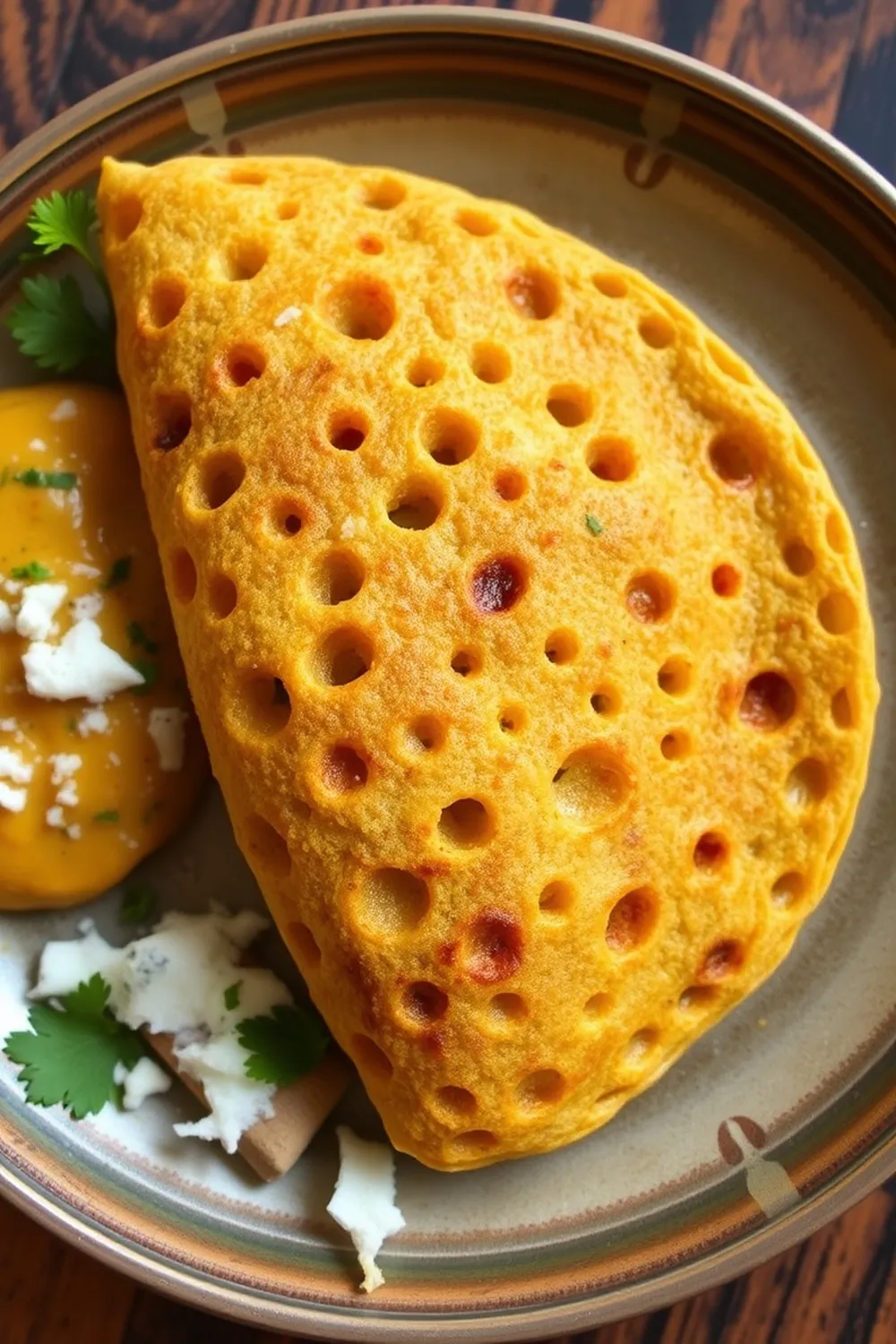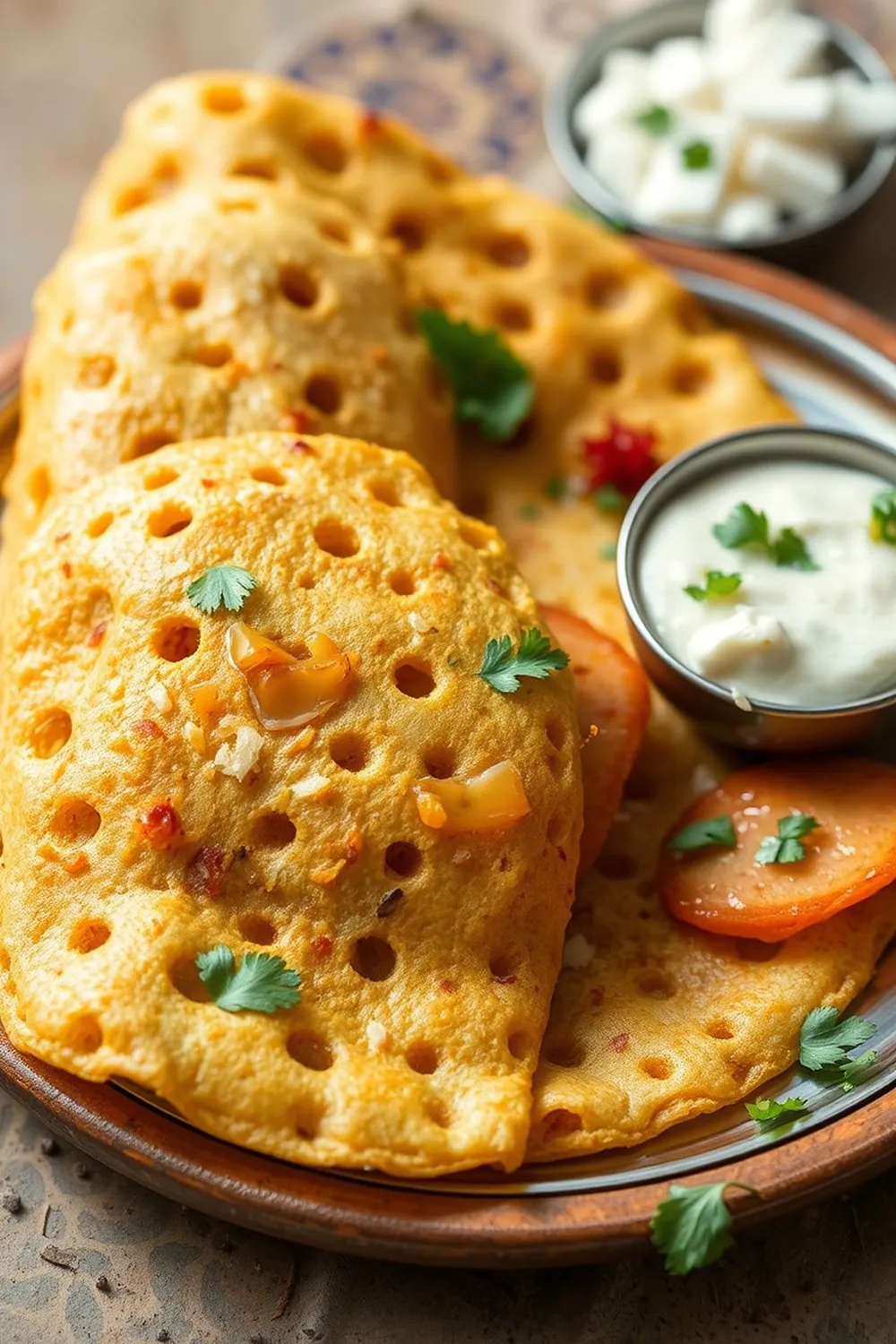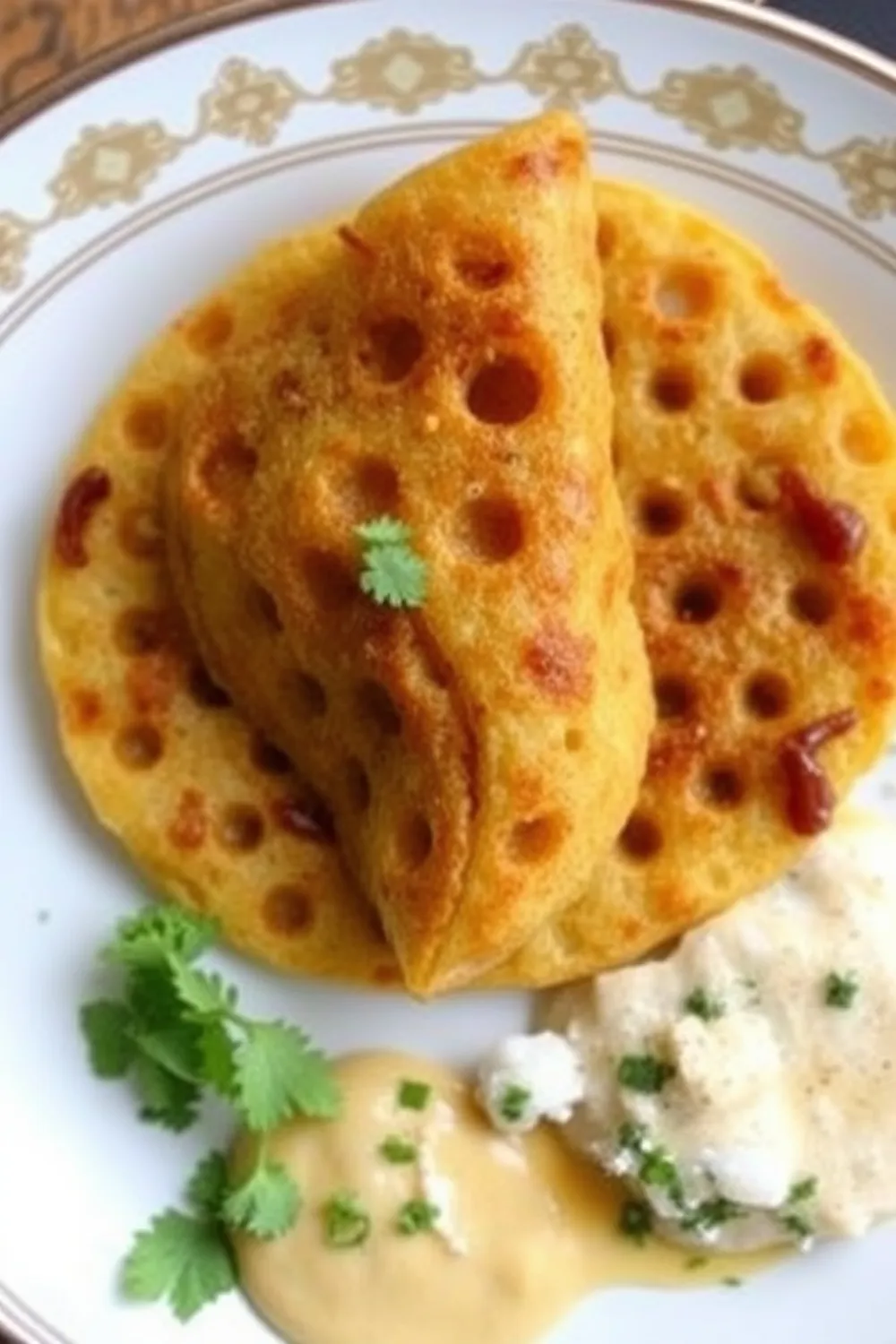- Pressure cook jackfruit seeds until tender, remove the skins, and grind into a smooth paste.
- Soak rice and methi seeds together for 3-4 hours. Soak urad dal separately for at least 30 minutes.
- Drain rice and urad dal. Grind with soaked poha, coconut, and enough water to form a smooth batter.
- Mix the jackfruit seed paste into the batter and ferment overnight (8-12 hours).
- Add turmeric powder and salt to the fermented batter. Adjust the consistency with water as needed.
- Heat a lightly greased griddle or tawa on medium heat. Pour a ladleful of batter onto the griddle without spreading it.
- Drizzle oil around the edges of the dosa, cover with a lid, and cook until small bubbles or perforations form on the surface (2-3 minutes).
- Remove the dosa from the griddle without flipping. Serve hot with chutney or sambar.
- Calories:220 kcal25%
- Energy:920 kJ22%
- Protein:8 g28%
- Carbohydrates:35 mg40%
- Sugar:3 mg8%
- Salt:300 g25%
- Fat:6 g20%
Last Updated on 6 months ago by Neha Deshmukh
Jackfruit Seed Dosa Recipe – Authentic Karnataka Style
Introduction
Oh, dosa! Is there anything more comforting? I remember the first time my ajji (grandmother) made me this – a slightly different version, of course, but the magic was the same. This Jackfruit Seed Dosa isn’t your everyday dosa, though. It’s a little slice of Karnataka’s culinary heritage, and honestly, it’s a fantastic way to use every part of the jackfruit. It’s surprisingly delicious, incredibly nutritious, and a real conversation starter. Let’s get cooking!
Why You’ll Love This Recipe
This recipe is special for a few reasons. First, it’s a brilliant way to reduce food waste – those jackfruit seeds usually get tossed! Second, it’s packed with protein and fiber thanks to the seeds. And finally, the subtle nutty flavor the seeds add to the dosa is just… chef’s kiss. It’s a taste of home, a little bit different, and totally worth the effort.
Ingredients
Here’s what you’ll need to make about 20 dosas:
- 3 cups Rice (125 ml cup size) – approximately 375ml
- 20 Jackfruit Seeds (pressure cooked)
- 2 tbsp Urad Dal (split black lentils) – approximately 30ml
- 2 tbsp Poha (flattened rice) – approximately 30ml
- 1 tsp Methi Seeds (fenugreek seeds) – approximately 5ml
- 1 tbsp Grated Coconut – approximately 15ml
- 0.5 tsp Turmeric powder – approximately 2.5ml
- Salt to taste
- Oil as required
Ingredient Notes
Let’s talk ingredients! A few little tips from my kitchen to yours:
Jackfruit Seeds: A Regional Superfood
Don’t be intimidated by the seeds! Pressure cooking is key to softening them. Make sure they’re thoroughly cooked before you start. They should be easily mashed.
Rice Varieties for Dosa
I prefer using a short-grain rice like dosa rice or ponni rice for that perfect texture. But you can experiment! Long-grain rice will work in a pinch, but the dosa might be a little less crispy.
The Role of Methi Seeds
Don’t skip the methi seeds! They help with fermentation and add a lovely aroma. A little goes a long way, so stick to 1 tsp.
Urad Dal & Poha – The Perfect Combination
Urad dal gives the dosa its crispness, while poha adds to the lightness. Soaking both is crucial for a smooth batter.
Step-By-Step Instructions
Alright, let’s get down to business!
- First, pressure cook your jackfruit seeds until they’re super tender. Once cooled, remove the skins and grind them into a smooth paste. Set aside.
- Now, soak the rice with the methi seeds in plenty of water for at least 3 hours. Simultaneously, soak the urad dal separately for about 30 minutes.
- Drain the rice and urad dal really well. This is important! Then, in a blender or grinder, combine the soaked rice, urad dal, poha, coconut, and enough water to create a smooth batter.
- Mix in that lovely jackfruit seed paste into the batter. Give it a good stir to combine everything.
- Now comes the patience part. Cover the batter and let it ferment overnight – about 8-10 hours. The warmer the environment, the faster it will ferment.
- The next morning, add the turmeric powder and salt to the fermented batter. If the batter seems too thick, add a little water to adjust the consistency. It should be pourable but not too runny.
- Heat a well-greased griddle or tava on medium flame. Pour a ladleful of batter onto the hot griddle – don’t spread it! Let it cook naturally.
- Drizzle a little oil around the edges of the dosa. Cover with a lid and cook for 2-3 minutes, or until you see little perforated holes forming on the surface.
- Gently remove the dosa from the griddle – no flipping needed! Serve immediately while it’s hot and crispy.
Expert Tips
A few things I’ve learned over the years…
Achieving the Right Batter Consistency
The batter should be similar to pancake batter – easily pourable but not watery. If it’s too thick, the dosas will be dense. Too thin, and they’ll be flimsy.
Fermentation – Key to Soft Dosas
Fermentation is everything. A well-fermented batter will result in light, fluffy dosas. If it’s cold, you might need to ferment for longer.
Griddle Temperature Control
Medium heat is your friend. Too hot, and the dosa will burn. Too low, and it will be sticky.
Variations
Want to switch things up? Here are a few ideas:
- Vegan Adaptation: This recipe is naturally vegan! Just ensure the oil you use is plant-based.
- Gluten-Free Confirmation: This recipe is naturally gluten-free.
- Spice Level Adjustment: Add a pinch of red chili powder to the batter for a little heat. My friend, Priya, loves adding finely chopped green chilies too!
- Karnataka Festival Adaptations: In some parts of Karnataka, these dosas are offered as naivedyam (offering) during certain pujas and festivals. It’s considered auspicious!
Serving Suggestions
Jackfruit Seed Dosa is delicious on its own, but even better with…
- Coconut chutney – a classic pairing!
- Tomato chutney – adds a tangy kick.
- Sambar – a lentil-based vegetable stew.
- A simple onion-tomato relish.
Storage Instructions
Leftover dosa batter can be stored in the refrigerator for up to 2 days. It might need a little stirring before using. You can also freeze the batter for longer storage.
FAQs
Let’s answer some common questions:
What is the best way to cook jackfruit seeds for this recipe?
Pressure cooking is the easiest and most efficient method. Ensure they are fully cooked until soft and easily mashed.
Can I use store-bought dosa batter instead of making it from scratch?
You can, but the flavor won’t be quite the same. Homemade batter really makes a difference!
How do I know if the dosa batter has fermented properly?
The batter will have increased in volume and will have a slightly sour aroma. You’ll also see tiny bubbles on the surface.
What kind of chutney or curry pairs best with Jackfruit Seed Dosa?
Coconut chutney is a classic, but tomato chutney and sambar are also fantastic choices.
Can I make this dosa using brown rice?
You can, but it might affect the texture. Brown rice takes longer to cook and might result in a slightly coarser dosa. You may need to soak it for a longer period.







